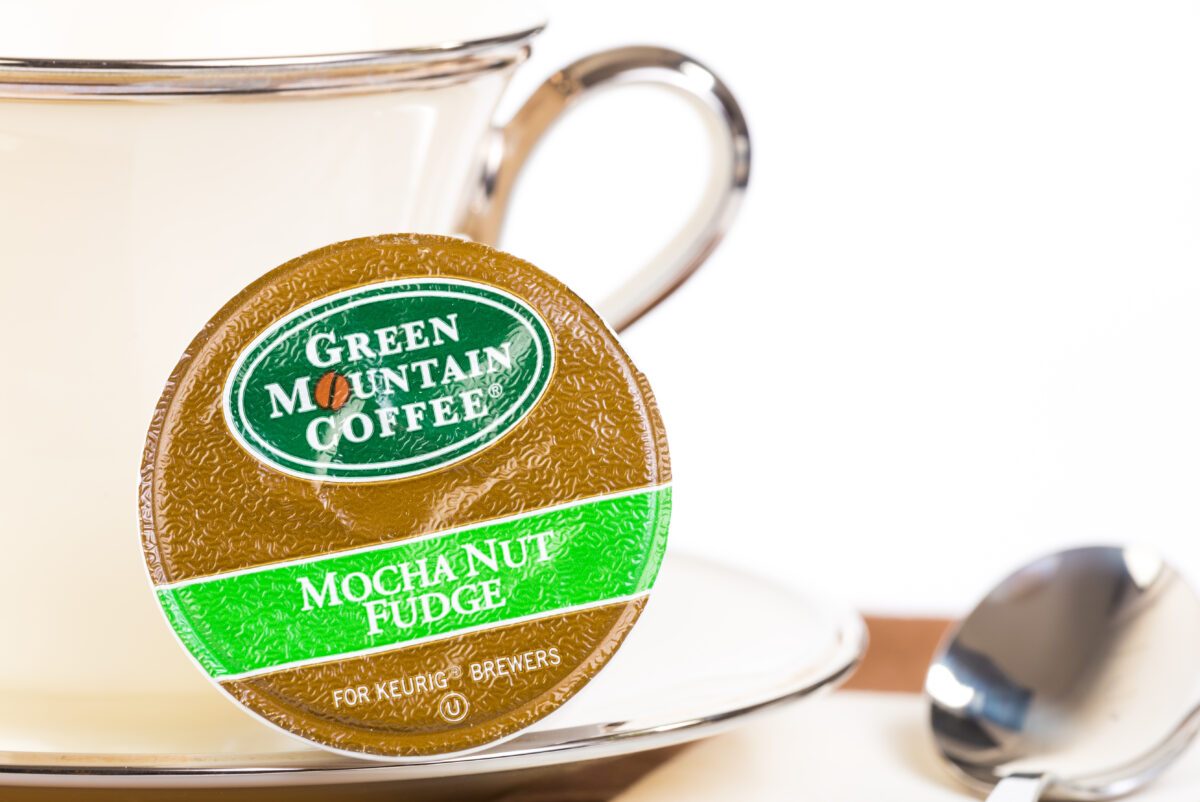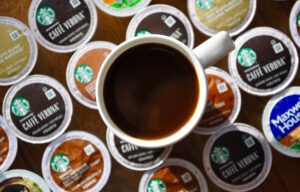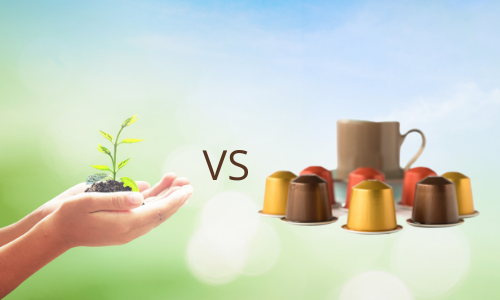K-cups and coffee pods: Are you causing harm to the environment with your quick fix for java?
Tiffany Mooney, a 29-year old American, uses a single-serving coffee brewing system for her daily cup.
She starts the day by filling the at-home brewer with a pint size plastic coffee capsule. Her hot beverage is ready in a matter of minutes. To keep her going, she adds a Cappuccino-flavored plastic-encased coffee brew at lunchtime.
Just before bed, Hanceville resident in Alabama chooses a “relaxing hot chocolate flavor.”
Mooney claimed that the Walmart-brand coffeemaker was her life. “But, I know that throwing away the little cups after I use them in the trash is not the most eco-friendly thing to do.”
She is correct.
They’re compact, portable and packed with every flavor you can imagine.
For some, they’re pricey to buy. Others buy them in bulk by the dozen. Regardless of how or where you buy the 2-by-2-inch pods, these modern-day coffee containers increasingly contribute to the mountain of plastic that’s ending up in landfills.
Plastic is probably what you eat. Yuck! A study shows that 90 percent of sea salts contain plastic.
These are the straws how little plastic straws can cause havoc in our oceans
To put it mildly, “Coffee pods are one of the best examples of unnecessary single-use plastics that are polluting our planet,” said John Hocevar, the campaign director of Greenpeace USA, an environmental nonprofit organization. Many end up being incinerated, dumping toxic chemicals into our air, water, and soil.”
The coffee pods could end up in rivers, where they can be swept into oceans and lakes. Hocevar explained that plastic can break down over time into smaller pieces, which chokes and kills wildlife.
K-Cups, Nespresso Capsules or any other brand, coffee pods can make one cup of coffee in a small aluminum or plastic container with foil lids. Despite being substantially more expensive per pound than regular coffee brewed in a pot, they’ve been the go-to solution for caffeine addicts who need a quick fix since the ’90s.
But the big boom happened around 2012, according to the National Coffee Association (NCA). This method was used by about 10% of coffee drinkers in 2012, with the percentage increasing each year.
The number of users has more than doubled by 2018. Today, 41 percent of Americans own a single-cup coffee maker, according to NCA and Statista, a market research firm.
Popular brands such as Kraft Heinz Co., Folger Coffee Co., Keurig Green Mountain, Starbucks and Folger Coffee Co. are prominently displayed at drugstores, supermarkets, and select dollar chains across the country.
After growing popularity in the office market, Keurig, Inc. introduced K-Cups to the home in 2004. Hocevar stated that K-Cups sold so many in a decade, that if they were placed side-by-side, they could circle the globe ten times.
California, California! Iowa is not one of the states that has straw bans or mandated meatless Mondays.
Not a dollar? Dollar Tree claims it will increase the price of Family Dollar and close hundreds of Family Dollar stores

A Keurig spokesperson said the company sold 10.5 billion K-Cups for the fiscal year ending in September 2015, which is the last year public data was available, the Chicago Tribune notes.
After a $13.9 million buyout by JAB Holding Co., Keurig was taken private in 2016.
K-Cups’ recycle-resistant nature led to some cities banning them completely in many countries. In Hamburg, Germany, coffee pods were banned from state-run buildings as part of an environmental movement.
Even the creator of the K-Cup has stopped using them out of guilt, saying that he “feels bad sometimes” about the product’s wasteful impact, according to the Atlantic.
The Swiss company Nestle began making headway with its Nespresso coffee packaged in pods in the 1990s. Although there were concerns about waste, the negative effects are lessened by the pods being made from aluminum rather than plastic.
Hocevar stated that at least some aluminum can be recycled in the environment. Hocevar noted that excessive aluminum exposure could have adverse effects on the health.

Traceability is a key issue in recycling small coffee pods.
Many capsules are too small to be picked up by recycling plants’ sorting systems. Recycling centers can become overwhelmed by tons of trash. It is not always easy to find tiny capsules amongst the piles.
Hocevar stated that K-cups slow down the waste management system. They make it more difficult and expensive to recycle things that could otherwise be simple and cheap, such as aluminum cans.
In 2014, Keurig Green Mountain said it plans by 2020 to change the plastic composition in the billions of K-cup single-serving coffee containers it sells annually. The company began testing recyclable K-Cup pods in 2015 and is collaborating with waste management facilities to make sure recyclers can process the capsules.
The K-Cup is made of polypropylene and can be sorted, shrunk, and sold to companies that recycle plastic.
You can currently recycle K-Mugs and K-Carafes and Vue pods. Also, pods for two K-Cup types – Green Mountain Breakfast Blend Decaf and Green Mountain Breakfast Blend Decaf – are available.
Nespresso has a large corporate sustainability program, which includes a list of commitments detailing how it plans to change its operations to decrease its negative impact on the environment.
Nespresso plans to recycle the used capsules it collects into new capsules by 2020. This is in line with its environmental goals. In March 2019, the coffee capsule company announced plans to spend more than $1 million to allow for curbside recycling of its single-use packaging in New York City.
“Nespresso is committed to circular use of its products. We chose aluminum packaging because it protects the quality and can be recycled again and again,” stated Guillaume Le Cunff.
Nespresso also has pre-recycling bags that can hold 200 capsules. The bags can be dropped off at any UPS location free of charge, according to the website.
Many consumers have found creative ways to reuse the pods, such as creating art or using them for tiny flower pots.
Mooney, a coffee pod fan, said that Mooney and Mooney have been working together on projects like tea parties with Mooney’s 7-year old niece. They are used to measure medication for my cat and dog. The perfect size to hold a cup of medication are coffee pods.
However, some critics remain skeptical about the future prospects of coffee pods.
K-cups and coffee pods: Are you causing harm to the environment with your quick fix for java?
Tiffany Mooney, a 29-year old American, uses a single-serving coffee brewing system for her daily cup.
She starts the day by filling the at-home brewer with a pint size plastic coffee capsule. Her hot beverage is ready in a matter of minutes. To keep her going, she adds a Cappuccino-flavored plastic-encased coffee brew at lunchtime.
Just before bed, Hanceville resident in Alabama chooses a “relaxing hot chocolate flavor.”
Mooney claimed that the Walmart-brand coffeemaker was her life. “But, I know that throwing away the little cups after I use them in the trash is not the most eco-friendly thing to do.”
She is correct.
They’re compact, portable and packed with every flavor you can imagine.
For some, they’re pricey to buy. Others buy them in bulk by the dozen. Regardless of how or where you buy the 2-by-2-inch pods, these modern-day coffee containers increasingly contribute to the mountain of plastic that’s ending up in landfills.
Plastic is probably what you eat. Yuck! A study shows that 90 percent of sea salts contain plastic.
These are the straws how little plastic straws can cause havoc in our oceans
To put it mildly, “Coffee pods are one of the best examples of unnecessary single-use plastics that are polluting our planet,” said John Hocevar, the campaign director of Greenpeace USA, an environmental nonprofit organization. Many end up being incinerated, dumping toxic chemicals into our air, water, and soil.”
The coffee pods could end up in rivers, where they can be swept into oceans and lakes. Hocevar explained that plastic can break down over time into smaller pieces, which chokes and kills wildlife.
K-Cups, Nespresso Capsules or any other brand, coffee pods can make one cup of coffee in a small aluminum or plastic container with foil lids. Despite being substantially more expensive per pound than regular coffee brewed in a pot, they’ve been the go-to solution for caffeine addicts who need a quick fix since the ’90s.
But the big boom happened around 2012, according to the National Coffee Association (NCA). This method was used by about 10% of coffee drinkers in 2012, with the percentage increasing each year.
The number of users has more than doubled by 2018. Today, 41 percent of Americans own a single-cup coffee maker, according to NCA and Statista, a market research firm.
Popular brands such as Kraft Heinz Co., Folger Coffee Co., Keurig Green Mountain, Starbucks and Folger Coffee Co. are prominently displayed at drugstores, supermarkets, and select dollar chains across the country.
After growing popularity in the office market, Keurig, Inc. introduced K-Cups to the home in 2004. Hocevar stated that K-Cups sold so many in a decade, that if they were placed side-by-side, they could circle the globe ten times.
California, California! Iowa is not one of the states that has straw bans or mandated meatless Mondays.
Not a dollar? Dollar Tree claims it will increase the price of Family Dollar and close hundreds of Family Dollar stores
A Keurig spokesperson said the company sold 10.5 billion K-Cups for the fiscal year ending in September 2015, which is the last year public data was available, the Chicago Tribune notes.
After a $13.9 million buyout by JAB Holding Co., Keurig was taken private in 2016.
K-Cups’ recycle-resistant nature led to some cities banning them completely in many countries. In Hamburg, Germany, coffee pods were banned from state-run buildings as part of an environmental movement.
Even the creator of the K-Cup has stopped using them out of guilt, saying that he “feels bad sometimes” about the product’s wasteful impact, according to the Atlantic.
The Swiss company Nestle began making headway with its Nespresso coffee packaged in pods in the 1990s. Although there were concerns about waste, the negative effects are lessened by the pods being made from aluminum rather than plastic.
Hocevar stated that at least some aluminum can be recycled in the environment. Hocevar noted that excessive aluminum exposure could have adverse effects on the health.
Traceability is a key issue in recycling small coffee pods.
Many capsules are too small to be picked up by recycling plants’ sorting systems. Recycling centers can become overwhelmed by tons of trash. It is not always easy to find tiny capsules amongst the piles.
Hocevar stated that K-cups slow down the waste management system. They make it more difficult and expensive to recycle things that could otherwise be simple and cheap, such as aluminum cans.
In 2014, Keurig Green Mountain said it plans by 2020 to change the plastic composition in the billions of K-cup single-serving coffee containers it sells annually. The company began testing recyclable K-Cup pods in 2015 and is collaborating with waste management facilities to make sure recyclers can process the capsules.
The K-Cup is made of polypropylene and can be sorted, shrunk, and sold to companies that recycle plastic.
You can currently recycle K-Mugs and K-Carafes and Vue pods. Also, pods for two K-Cup types – Green Mountain Breakfast Blend Decaf and Green Mountain Breakfast Blend Decaf – are available.
Nespresso has a large corporate sustainability program, which includes a list of commitments detailing how it plans to change its operations to decrease its negative impact on the environment.
Nespresso plans to recycle the used capsules it collects into new capsules by 2020. This is in line with its environmental goals. In March 2019, the coffee capsule company announced plans to spend more than $1 million to allow for curbside recycling of its single-use packaging in New York City.
“Nespresso is committed to circular use of its products. We chose aluminum packaging because it protects the quality and can be recycled again and again,” stated Guillaume Le Cunff.
Nespresso also has pre-recycling bags that can hold 200 capsules. The bags can be dropped off at any UPS location free of charge, according to the website.
Many consumers have found creative ways to reuse the pods, such as creating art or using them for tiny flower pots.
Mooney, a coffee pod fan, said that Mooney and Mooney have been working together on projects like tea parties with Mooney’s 7-year old niece. They are used to measure medication for my cat and dog. The perfect size to hold a cup of medication are coffee pods.
However, some critics remain skeptical about the future prospects of coffee pods.
KillTheKCup.org has a petition to bring attention to the increasing waste generated by K-Cups.
“We are not asking the manufacturer for a change. The website states that we are asking governments to kill the K-Cup.Why not use non-compostable K-Cups?
In 2015, the internet went wild when “Kill the K-Cup”, a disaster movie about killing coffee pods, was released. This spoof movie depicts coffee pod-shaped monsters that disembark from flying saucers to rain terror on a city with Keurig pods.
Others are more optimistic about the future convenience of coffee containers.
Hocevar stated that “the big producers like Nestle and Starbucks are clearly aware of the problem and understand it really well.” “They are slowly working to reduce the problems. The future is reusable and refillable options.
on to bring attention to the increasing waste generated by K-Cups.
“We are not asking the manufacturer for a change. The website states that we are asking governments to kill the K-Cup.Why not use non-compostable K-Cups?
In 2015, the internet went wild when “Kill the K-Cup”, a disaster movie about killing coffee pods, was released. This spoof movie depicts coffee pod-shaped monsters that disembark from flying saucers to rain terror on a city with Keurig pods.
Others are more optimistic about the future convenience of coffee containers.
Hocevar stated that “the big producers like Nestle and Starbucks are clearly aware of the problem and understand it really well.” “They are slowly working to reduce the problems. The future is reusable and refillable options.

